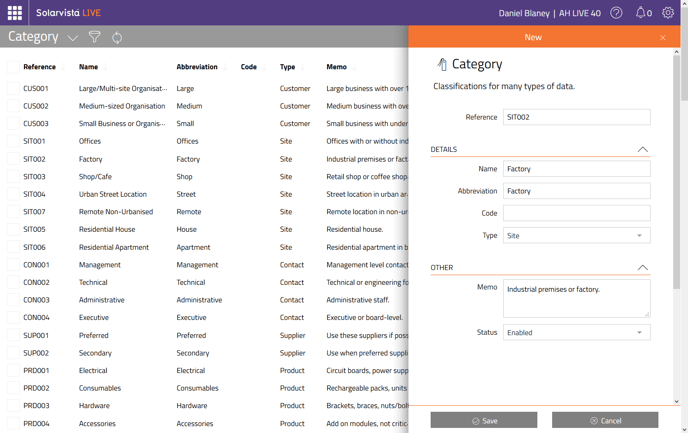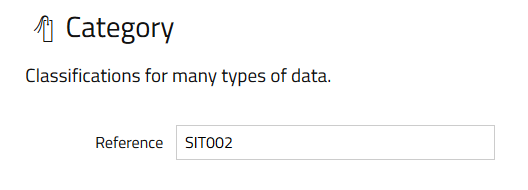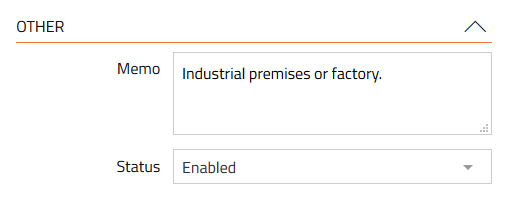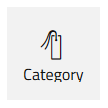Categories
An explanation of and detailed look at the fields and dependencies in the Category data source, and how to create a new record.
![]()
The “Category” file holds a classification record for other records such as Customer, Product, etc. This is denoted by the field ‘Type’. Categories enable classification of data which is useful for reporting and business analysis. Pricing Policies ![]() , that determine pricing discounts use Product Categories to determine different pricing models. Many record types have Category fields, but they all associate with the same Category file. Only the “Type” field set accordingly differentiates them. Categories are also used as a “Sector” to group Industry records so are pre-filled accordingly by default.
, that determine pricing discounts use Product Categories to determine different pricing models. Many record types have Category fields, but they all associate with the same Category file. Only the “Type” field set accordingly differentiates them. Categories are also used as a “Sector” to group Industry records so are pre-filled accordingly by default.
Some features are dependent upon your select plan for your account.
Indicates a feature is only available in Standard or above.
Indicates a feature is only available in Enterprise.

Where Category Records are Used
The following files refer to Category records so if you plan to use any of these, setting up the records in this file will be important or even critical:
Data Sources:
- Customers
- Sites
- Contacts
- Suppliers
- Products
- Equipment
- Agreements

- Pricing Policy

- Skills

- Actions
- Problems
- Causes

- Symptoms

- Resolutions
- Certifications

- Teams
- Leave/Holidays

- Projects
- Industries
Activity/Forms
- Extra Travel
- Request Leave/Holiday
Pre-requisite Files for Category Records
When setting up Category records, it is recommended to review the other data files that may need to be referred to by each record. These are the files that you may need to setup in advance:
None.
Field Descriptions for Category
The ID section holds the unique ID and names for the category:

Reference - holds the unique ID for the record (most records in Solarvista have one of these). It cannot contain any spaces or non-standard characters. Once the record is saved, it is not possible to edit it afterwards. In most default situations, the Reference is automatically set using a counter sequence, however, you can setup your own if you prefer.
The Details section holds the detail of the Category:

Name - the formal name of the Category.
Abbreviation – a shorter name used where space short.
Code – an alternative code for the Category.
Type – defines the record that the Category relates to.
The Other section holds status:

Memo – free text notes used to describe the Category definition.
Status – defines the status of the record as follows:
- Disabled – is not active. The record will not appear for selection in other parts of the system.
- Enabled – is active. The record will appear for selection in other parts of the system.
Creating a New Category Record
To create a new Category record:
- Click on the “Plus” button.

A menu will appear. - Within the “Data Sources” section, find “Category”.

- Click on “Category”.
- A new “empty” Category record will appear.
- Populate all fields as you require.
- Populate all fields as you require.

- Click on the “Save” button. You may need to refresh the page to see the new record in a view.

Editing a Category Record
To edit a Category record:
- From the main menu, select Categories.

The default view for Categories will open. - Click on the Quick Filter button.

- Enter criteria for the Category record you are looking for and click Apply button.

- The view will update. Find the record you are wanting to edit.
- Click anywhere on the row that shows the record. The record will open.
- You can edit any field that allows editing (some could be set to read only).
- Click on “Save” button to save changes.

Deleting a Category Record
To delete a Category record.
- From the main menu, select Categories. The default view for Categories will open.
- Click on the Quick Filter button.

- Enter criteria for the Category record you are looking for and click Apply button.

- The view will update. Find the record you are wanting to delete.
- On the left side of the view is a column containing checkboxes.
- Check the box of the record you want to delete.
- Click the “Delete” button on the top right.

A slide in dialog will appear prompting you to confirm the delete, by typing in the word “DELETE” again. - To confirm, click the “Delete” button and the record (or records will be deleted).

Note: You cannot delete a Category record that is already in use with a Work Item i.e. Jobs. You can delete Category records referred to only by other Data Sources however this will leave those records without an associated to a valid Category record. If this happens by accident, you can manually recreate the record ensuring the Reference is identical. You can also change the status of the record to prevent it appearing on screen in future whilst maintaining historical integrity.
Customising or Adding New Fields
Solarvista™ is built upon our unique no-code application platform that allows you to edit fields (or remove them in some cases) as well as add your own fields. These new fields (or edited characteristics of existing fields) automatically become available within the web portal and the mobile apps. For more information, refer to the Customising section.
Importing Cause Data in Bulk using Import Tool
If you have a lot of Cause information to enter, you may prefer to upload this using the Import Tool that’s built into Solarvista. The Import Tool enables Cause records to be created from “CSV” text files. CSV files can be created from a wide range of popular applications including Microsoft Excel. For more information on importing data into Solarvista, please refer to the article here.
Continue the Setting Up Data series with Industries.